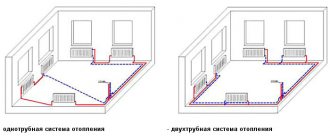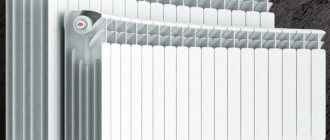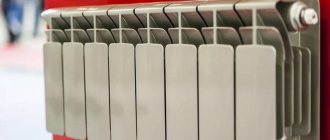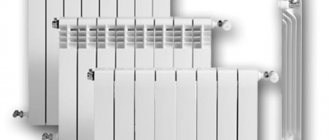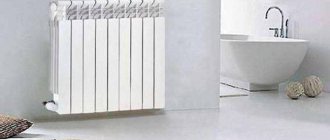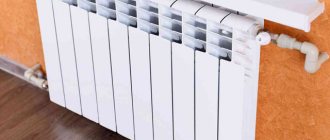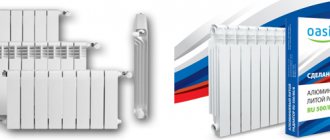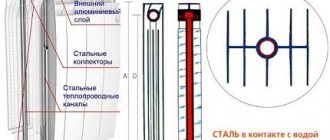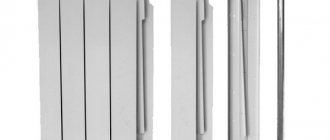Surely, many residents of city apartments face such a problem when the apartment feels cold in winter. Insufficient heat can be caused by poorly insulated doors and windows, the presence of air in the radiators, or their contamination with various deposits contained in the coolant.
But it is quite possible that, for one reason or another, there are few radiators installed in the apartment, which affects the insufficient temperature in the house. In this case, there is naturally only one way out - adding sections of heating radiators. But before you begin this very difficult procedure, you should rule out all other causes of insufficient heat.
How to add sections
After you have experimentally determined that the reason for the cool temperature in the house is not a clogged radiator, you should find a store near your home (so that you don’t have to travel far away and thereby waste your time) that sells heating equipment.
You need to buy the same sections that your radiator is equipped with - made of cast iron, aluminum, or bimetallic. It should not happen that you select inappropriate sections - because of such an error, you simply will not be able to add them, that is, the money spent will be thrown away, so be careful. The procedure for increasing sections is carried out in the same sequence of actions for all types of heating radiators.
To join sections, you need a connecting nut - nipple
Let's proceed directly to increasing the number of sections. The first step is to unscrew the fitting using a radiator wrench on the side to which you plan to add one or more elements. After you have unscrewed the fitting, a nipple (connecting nut) is placed in the area where the sections join. The following important feature must be taken into account: the threads at different ends of the nipple are different, and in order to correctly install new sections you must follow the following rules:
- The right side of the nipple should be directed towards the direction where the connection to the new element will be made;
- Accordingly, the left one is towards the already present sections of the heating radiator.
In order to prevent further leakage of the battery, you should put intersection gaskets on the nipple (they can be rubber, paranitic, or gel)
At the same time, they must be put on carefully and carefully - this will guarantee that the gasket will be positioned as evenly as possible, without unwanted distortions. Next you need to tighten the thread
This action should also be carried out without sudden movements, in a leisurely rhythm, and carefully. If you want to build a high-quality heating radiator, then there can be no rush.
To prevent leakage, an intersection gasket is required
Damage to metal threads is extremely undesirable - this may result in not the most harmless problems, the solution of which will require you to additionally spend your own time and financial resources.
The enlarged radiator must be placed back on the bracket and the connection to the central heating pipe restored. To do this, you need to arm yourself with a wrench of the appropriate diameter and tow, which is necessary for wrapping the pipe threads when screwing the radiator.
It’s not difficult to add sections to a heating radiator; you don’t need to work in a team of heating installers for 10 years. But this process cannot be done without a serious approach, the availability of basic tools and the removal of your personal time. However, you can resort to the second option for solving the problem of insufficient heating of the room - becoming a client of a company providing such services, whose employees will do everything themselves, quickly and efficiently.
Preparation
Before expanding the battery, it must be removed and properly prepared. The device is cleaned of dust and rust, after which the threaded hole intended for connecting the battery and the supply pipe is inspected. As a rule, over years of use, growths form on it due to increased water hardness and the presence of bleach in it.
It is imperative to get rid of these formations. To do this, use sandpaper to process the threaded hole. In this case, you need to observe special care, because even small residues of build-up will prevent the sealing of the gaskets. In the future, this leads to the appearance of leaks along the commutation interface.
Installation of aluminum heating radiators
Assembling and adjusting a heating system is a responsible task, and it is best handled by professionals. But if you wish, you can install aluminum radiators yourself.
First you need to assemble the device:
- Screw in the supplied plugs and plugs.
- Assemble thermostats and connect shut-off valves at the inlet and outlet of the device.
- Check the nipples and secure the air valves.
A diagram for assembling and disassembling the device is included in the kit. It is better if the assembly is carried out by a specialist, then there will be a guarantee that all the taps are installed correctly. It is not allowed to clean aluminum with abrasives when installing adapters or extending sections - coolant may leak.
Attention! The air valves must be screwed in such a way that at the end of the process their outlet heads point upward. Having marked the installation location of the battery under the window in accordance with the indicated indentations, brackets are attached to the wall
To do this, you need to drill holes with a hammer drill and insert plastic dowels, and screw the brackets into them. When screwing in the fasteners, from time to time you need to hang the radiator on them to maintain a distance of 5 cm from the wall
Having marked the installation location of the battery under the window in accordance with the indicated indentations, brackets are attached to the wall. To do this, you need to drill holes with a hammer drill and insert plastic dowels, and screw the brackets into them. When screwing in the fasteners, from time to time you need to hang the radiator on them to maintain a distance of 5 cm from the wall.
Battery connection diagrams
The device can be connected in several ways:
Diagonal. Experts consider it the most energy efficient. The supply pipe is connected to the upper pipe, and the outlet pipe to the lower pipe, but on the opposite side of the radiator. With this scheme, the battery releases into space the maximum thermal energy received from hot water. The disadvantage of this method is that the pipes running on top do not fit well into the design of the room.
Side. The pipe supplying the coolant is connected to the side fitting (right or left), the return – to the parallel bottom one. If the pipes are installed in the reverse order, the heat output of the device will drop by 50%. This scheme for connecting aluminum heating radiators does not work effectively if the sections have a non-standard size or their number exceeds 15.
From a design point of view, aluminum radiators with bottom connections win. With such a layout, the pipes are not visible; they are hidden in the floor or wall. The batteries are connected to the system through pipes located at the bottom of the devices. Typically, bottom-connected radiators are installed on floor brackets. The battery is attached to the wall with one hook, only to maintain balance.
Connection diagrams for heating radiators made of aluminum
Important! Aluminum batteries have standard parameters for the pipes, so there is no need to buy any additional adapters from the radiator to the pipes. The device is also supplied with a Mayevsky valve designed for bleeding air
Connection and commissioning
Before installing aluminum appliances, the autonomous system is washed with water. Alkaline solutions cannot be used.
Important! Aluminum is easily dented and scratched by tools, so it is better to mount the battery in the original plastic packaging. Once connected, the polyethylene can be removed
In an effort to connect aluminum heating radiators without high costs, some homeowners use blind, non-separable connections between pipes and radiators. But heating a home in the northern hemisphere is not something you skimp on. It would be wiser to install “American” ones - quick-release threaded units, when the pipes are connected and disconnected using one union nut.
The procedure for connecting radiators to the heating system:
- Make sure that there is no water in the system or that it is shut off at the installation points.
- Hang the radiator and connect it to the pipeline using fittings.
- Seal all threaded connections using plumber's tape. 4-5 turns in the thread direction are enough.
- Carry out a pressure test of the system.
Aluminum battery connected to the heating system
You can install an aluminum heating radiator yourself, but it would be wiser to entrust the job to specialists who have all the necessary permits to carry out such work. The slightest inaccuracy in installation can lead to leaks and inefficient functioning of the heating system.
Testing the assembled structure
After soldering the pipes, the most crucial moment comes - checking for water leaks. Some experts try to check the joints in a container of water, but, in essence, this is a waste of time, and nothing more. You can check how well the parts were connected only by pumping hot water into the system.
A bronze tap is usually installed at the entrance to the heating radiator. It will be needed to repair or adjust the heat supply to the system. If drops appear during filling, you will have to turn off the water, remove the plug and sequentially tighten the nuts.
Technique for performing work on connecting radiator sections
Extending radiators is a useful skill for a home handyman. Knowing how to join sections, it will not be difficult to provide your own microclimate in each room.
Before connecting two radiators, a power calculation is made. The formula is simple - 10 m2 requires 1 kW of thermal power. The section's performance is indicated in the data sheet. This data will be useful for calculations. Then you need to buy the required number of elements, find tools and assemble the heating device.
Tools and components for work
To assemble a heating radiator with your own hands, you will need:
- wrench or adjustable wrench;
- radiator key;
- plugs with right and left threads – 1 pc.;
- nipples;
- paronite gaskets;
- intersection gaskets made of durable, flexible material;
- battery sections;
- sandpaper of fraction No. 120.
Thread gloves are useful for protection. It is more convenient to install the batteries with two people; an assistant will not hurt.
Step-by-step battery expansion process
Do-it-yourself heating radiator assembly can be done at any time. If the heating season has already begun, the network must be shut off, the coolant must be drained from the circuit and the heating device must be dismantled.
How to connect the battery:
- Place the dismantled radiator on a horizontal plane. To avoid scratching the coating of the battery and table (floor), lay a cloth. Remove all additional elements - taps, temperature sensors. To wash the battery, take it into the bathtub, open the plugs and rinse with a stream of water.
Check the integrity of threaded connections and ends of the heating device. If there are deposits, sand the joints. Place the battery back on a flat, horizontal surface. The area is chosen to be level to ensure the tightness of the joint. The slightest curvature of the position will lead to an uneven joint. For seals, only paronite gaskets are chosen. This is a durable, flexible material that can withstand heat without loss of quality. Check the quality of nipple threads
Smooth and uniform cutting without chipping is the key to a strong joint. Move the sections together, placing spacers between them. Carefully begin to tighten the nipple. The part has a left-hand thread on one side and a right-hand thread on the other
This means that when rotating, both sections are attracted. It is more convenient to carry out work with a special radiator wrench. The tool may come complete with a battery, but is also sold separately.
- Grab the sections a little, check the evenness of the joints and tighten until tight. The number of turns of the nipple turns on each section must be equal.
Knowing how to increase the heating battery, it is not difficult to assemble a system with the required power indicators. After building up the sections, the radiator is checked for leaks.
For a household check you will need:
- a piece of pipe with a cross section of 15 mm;
- automobile pump with pressure gauge;
- tire nipple.
Now solder the nipple to the pipe and insert it into the radiator. This design is needed for air pressure testing. Install a plug on one of the radiator inlets. Connect a car pump with a pressure gauge to the nipple. Pump air at a pressure of 1 bar. If the tightness of the joints is broken, a whistle of escaping air will appear. You need to find a leak, tighten the nipple or change the gasket. Carry out the pressure test again. If there are no leaks, install the radiator into the network.
Pressure testing with water is carried out in the same order. Instead of air, colored water is pumped in. Let the device stand for 5 hours and inspect for leaks. If there is a leaky joint, water will leak out. Tighten the joints, check again, install the battery into the system.
An extended battery increases in weight. Before installing the radiator, it is advisable to strengthen the fasteners and screw in additional brackets. This will protect the device from collapse, because the battery will be even heavier with coolant. The device is integrated into the network at a selected location, taking into account the increase in battery length.
Materials and tools
Before you start building up batteries in sections, you need to prepare the tools and materials that you cannot do without:
- Required number of sections;
- Gas key;
- Key for connecting/disconnecting sections;
- Nipples for the heating system (connection fittings between sections);
- Sandpaper;
- Seals for installation between sections;
- Side plugs with versatile threads;
- Gaskets for plugs.
Connection diagrams
The most fault-tolerant scheme for connecting heating radiators in a private house with a bottling and boiler is a single-pipe Leningradka. Heating appliances are connected parallel to the bottling line, which is laid around the perimeter of the room.
Somewhat cheaper to install, but noticeably more problematic to operate, is a circuit that uses a series connection of batteries. Suffice it to say that their independent adjustment in this case is impossible.
A variant of a single-pipe circuit with a serial connection.
Finally, a two-pipe system involves connecting each radiator as a jumper between the supply and return lines. It is inconvenient in that it requires the already mentioned balancing - limiting the passage of the heating devices closest to the boiler.
What are the possible diagrams for connecting heating radiators to the supply line?
- One-sided. The connections are connected to the upper and lower radiator plugs on the right or left. It is compact, but makes the heating of the device uneven: the last sections will always be colder than the first.
- From bottom to bottom. In this case, the battery must be equipped with an air vent. The advantages of the solution are that the radiator with this connection does not require flushing and always heats along its entire length.
- Diagonal. Heating of sections is even more uniform; however, the lower corner of the device with a blind plug will gradually silt up.
Connection options for liners.
Advice from professionals
If you plan to add a significant number of sections, you need to use brackets. Without them, a new heavy radiator risks breaking existing pipes and causing an accident.
Other important points:
- Aluminum products cannot always be attached to existing radiators. Those made using extruded technology are not suitable for such work, since they have a non-separable design.
- Bimetal can be expanded without problems, since its design is sectional.
- When connecting the assembled battery, the length of the lounger is reduced by cutting off a piece of material with a grinder to the required size. As a result, there will be no thread at the end of the pipeline.
You can make the connection yourself, the main thing is to follow the rules and do not forget about the need for comprehensive testing of the system before launch.
It is important to follow the rules for connecting old and new sections
And one more thing - installation of cranes is not a mandatory procedure, it is done at your own discretion. If increasing the power of the device requires the installation of one rather than a set of sections, it is enough to follow the standard instructions.
Bimetallic heating radiators
Comparative characteristics with other types of batteries
The photo shows a tall narrow device.
First you need to understand what kind of heating radiators there are, and how they differ from each other.
We list the main types:
- Cast iron batteries are one of the most common types, found in most Soviet-era apartments. It is a system of connected cast iron sections with fairly thick walls and a large mass. It is characterized by high strength and durability, but has low efficiency and heat transfer, and one can also note high thermal inertia;
- Steel tubular registers are a system of pipes of sufficiently large diameter, or one pipe in the form of an S-shaped bend (for example, a heated towel rail). This type of device is usually installed in large premises - concert halls, cinemas, sports complexes, supermarkets. They are distinguished by high power and large volume of coolant;
- Steel heating panels. They are welded profiled steel plates, inside of which there are channels for coolant circulation. They have a fairly low resistance to water hammer and low strength, are susceptible to corrosion and are not very reliable;
- Aluminum radiators are a more modern type of battery, which is characterized by increased heat transfer and efficiency, low coolant volume and low weight of the device. Due to low thermal inertia, they lend themselves well to automatic and manual temperature control. They are demanding on the quality of the coolant and its acidity, have average strength and service life;
- Copper batteries are a system of tubes with plate fins. They are distinguished by the highest heat transfer and efficiency, high strength and resistance to water hammer, lack of corrosion and long service life. The only drawback of copper units is the high price;
- Bimetallic radiators resemble aluminum devices in appearance and design, with the difference that the inner walls of the channels are made of steel or copper. In this way, it is possible to increase the efficiency and heat transfer of the battery, but maintain its strength and durability.
A cast iron battery familiar to many.
To understand the main distinguishing feature of a bimetallic device, you should better understand its design. The main task of any liquid-cooled battery is to ensure maximum heat transfer from the coolant to the environment, while at the same time having a sufficient supply of mechanical and corrosion strength for long-term efficient operation.
The degree of heat transfer directly depends on the thermal conductivity of the metal and the thickness of the walls. The most thermally conductive materials are aluminum and copper, so the most efficient devices are made of non-ferrous metals.
The most efficient radiators are made from copper.
On the other hand, steel and ferrous metals demonstrate the highest strength. But they are susceptible to corrosion and have low thermal conductivity. At the same time, steel is much cheaper than copper and aluminum, which is also an advantage.
The design of the bimetallic radiator is distinguished by the fact that the internal walls of the channels are made of durable anti-corrosion steel or pure copper, and the external walls and fins are made of lightweight and heat-conducting aluminum. This solution made it possible to combine the advantages of steel and non-ferrous metals in one device.
The inner surface of the channels and manifold is made of steel.
Important! Bimetallic radiators combine the advantages of products made of ferrous and non-ferrous metals, becoming the most progressive and modern type of heating devices
Advantages and disadvantages
The convector fits perfectly into a modern interior.
Let's consider the positive and negative aspects of using units with combined metals in their composition. Let's start with the advantages:
Cast iron batteries
If we are talking about expanding cast iron batteries, then it is necessary to carry out work to increase the radiator area when the heating season is over. The fact is that to add new sections, you will need to completely disassemble the radiator. To do this, it will naturally have to be disconnected from the heating system. If you do this in winter, the entire system will have to be shut down. It is unlikely that any of your neighbors will be happy to learn that they will have to sit without heat for a couple of hours. This is the best case scenario.
Therefore, no matter how much you would like to increase the heat output from the batteries, try to be patient until the heating season ends. If cast iron radiators are installed in a private house, then you can decide the question of when to replace them yourself. So, take a step-by-step look at how to build up a cast iron battery.
To add additional sections you will need the following tool:
- radiator wrench or adjustable wrench;
nipples designed specifically for cast iron batteries (their number directly depends on the number of sections you install);
(See also: How to shut off a radiator)
special gaskets for installation between battery sections;
Side plugs with gaskets (gaskets are usually made of a material such as paronite).
The first thing you will have to do is remove the battery and disassemble it. Don't forget to turn off the water. It is quite simple to build up a cast iron heating radiator; the most important thing is to try to clean everything thoroughly so that the joints connecting the sections do not subsequently leak.
If the batteries are no longer new and have been used for a sufficient amount of time, then a kind of build-up of rust and dirt may form between the sections. In order to put on the gasket and connect the sections, this build-up will have to be removed. The intersectional space is cleaned either with coarse sandpaper or a brush with metal bristles.
lay out the battery and additional sections on the floor. When you attach the nipple, pay close attention to the position of the thread. It’s better to make sure once again that you have correctly positioned the element that you will screw into two sections with different threads. (See also: How to blow out a radiator)
We begin to screw in the nipple from the left side; for this it is advisable to initially screw it somewhere on one turn of thread on the left side of the battery. Perform similar actions on the right side.
Make sure that the intersection gasket is located exactly in the middle of the nipple. The sections should fit tightly to the nipple. The next step is to insert the radiator key into the battery, and... I use an adjustable wrench and screw the nipple into the battery section.
After tightening the nipple 3-4 turns, move to the other side of the sections to be screwed. And so, one by one, tighten the sections until they fit very tightly. (See also: How to properly install a heating battery with your own hands)
Now install special side plugs for the cast iron battery. Don't forget about paronite gaskets. If the surface on which the gasket will be attached has a build-up of rust, we also clean the surface with sandpaper. And only after that we install the plug with the gasket. Tighten the plugs tightly using a pipe wrench.
These are actually all the stages of work on installing additional sections of a cast iron battery. If you wish, in addition, you can install taps on the radiators.
By the way, the lack of heat in rooms that use cast iron radiators can arise not only due to an insufficient number of sections. Sometimes it happens that cast iron batteries that have been used for many years are periodically painted by applying a new layer of paint to the old one. (See also: How to remove a heating battery)
Such a “fur coat” subsequently leads to the fact that the thermal output of such radiators is reduced to almost zero. Therefore, if you decide to repaint or decorate your battery in some special way, be sure to remove the old layer of paint.
To paint a battery, choose not ordinary enamel, but paint that can interact with high temperatures without changing its qualities. Conventional enamels very often turn yellow when heated, so you must take their properties into account when choosing.
Radiator selection
You should start by choosing a radiator, and the main criterion for choosing will be the operating pressure for which the radiator is designed. For a private house with its own heating system, a radiator with a working pressure of 6-7 atmospheres will be sufficient, but if you need to connect a radiator to the central heating system of an apartment building, it must withstand a pressure of at least 10 atmospheres.
Currently, the consumer is offered two options for aluminum radiators - standard or European and reinforced. The latter can operate under pressure reaching 12 atmospheres. When connecting to a central heating system, you must choose among reinforced radiators.
The number of sections plays a big role
Next you need to decide on the required number of sections. To do this, we determine the amount of heat. Necessary for heating the room and divide by the heat transfer of one section of the selected radiator.
The amount of heat required for a standard room can be taken equal to 1 kW per 10 m 2 of room area. For non-standard premises and more accurate calculations, we will use a ready-made table:
Radiator power table
It should be remembered that the connection diagram for a battery of more than 12 sections must be double-sided, diagonal or saddle. With a one-sided battery connection scheme consisting of a large number of sections, a “pocket” of cold water will form on the side of the radiator opposite the pipes. “Extra” sections simply won’t work; we end up with harmful ballast.
Using forced injection, the battery can be expanded to 24 sections, even with one-way supply, but the radiator in this case must be reinforced.
It should be remembered that coolant must be supplied to reinforced radiators under high pressure only through metal pipes. Metal-plastic may not withstand such pressure, and the consequences will be the most dire.
It should also be taken into account that the heat transfer of the radiator indicated in the documentation is relevant only for one-sided or diagonal supply of coolant to the radiator. When using bottom feed, feel free to subtract 10-15 percent.
If the heating system is installed in a private house, then it is possible to choose the general heating arrangement yourself - one- or two-pipe.
Submitting an application
Before checking your international passport for validity on the website of the Federal Migration Service (now the Main Directorate for Migration Affairs of the Ministry of Internal Affairs), you need to take into account that biometric documents are not checked in this way. Citizens should contact the employees of the Ministry of Internal Affairs department on migration issues in person with a corresponding application. The reliability of this method is beyond doubt. In addition, you can find out from an employee of the Ministry of Internal Affairs whether the foreign passport issued before the suspended conviction is valid.
A response to a registered request is given after 30 days. The applicant receives a written response about the authenticity or invalidity of the foreign passport. This method is necessary to receive an official response. It can be presented to the court and other government bodies.
Placement of heating devices
It is of great importance not only how to connect heating radiators to each other, but also their correct location in relation to building structures. Traditionally, heating devices are installed along the walls of rooms and locally under windows to reduce the penetration of cold air flows in the most vulnerable place.
There are clear instructions for this in SNiP for installing heating equipment:
- The gap between the floor and the bottom of the battery should not be less than 120 mm. When the distance from the device to the floor decreases, the distribution of heat flow will be uneven;
- The distance from the back surface to the wall on which the radiator is mounted should be from 30 to 50 mm, otherwise its heat transfer will be impaired;
- The gap from the top edge of the heating device to the window sill is maintained within 100-120 mm (no less). Otherwise, the movement of thermal masses may be hampered, which will weaken the heating of the room.
Bimetallic heating devices
To understand how to connect bimetallic radiators to each other, you need to know that almost all of them are suitable for any type of connection:
- They have four possible connection points - two upper and two lower;
- Equipped with plugs and a Mayevsky valve, through which you can bleed the air collected in the heating system;
A diagonal connection is considered the most effective for bimetallic batteries, especially if we are talking about a large number of sections in the device. Although it is not advisable to use very wide batteries equipped with ten or more sections.
Advice! It is better to think about the question of how to properly connect two heating radiators of 7-8 sections instead of one device of 14 or 16 sections. It will be much easier to install and more convenient to maintain.
Another question - how to connect sections of a bimetallic radiator may arise when rearranging sections of a heating device in various situations:
The place where you plan to install the heating device is also important.
- In the process of creating new heating networks;
- If it is necessary to replace a failed radiator with a new one - bimetallic;
- In case of underheating, you can expand the battery by connecting additional sections.
Aluminum batteries
Interesting! By and large, it should be noted that a diagonal connection is an excellent option for any type of battery. You don’t know how to connect aluminum radiators to each other. connect diagonally, you won’t go wrong!
For closed-type heating networks in private homes, it is advisable to install aluminum batteries, since it is easier to ensure proper water treatment before filling the system. And their cost is much lower than that of bimetallic devices.
Of course, over time, moving through the radiators, the coolant cools
Of course, you will have to try hard before connecting the sections of the aluminum radiator for regrouping.
Advice! Do not rush to remove the factory packaging (film) from installed heating devices until finishing work in the room is completed. This will protect the radiator coating from damage and contamination.
https://youtube.com/watch?v=y9a35JHa0TM
The work process itself does not take much time, you do not need any special skills or expensive equipment, you can purchase all the necessary tools at any hardware store. And don’t forget, the connection will serve you for a long time and without hassle only if you used high-quality materials in your work and followed all the rules for installing the heating system.
We are talking about exactly what is indicated in this figure.
In the video presented in this article you will find additional information on this topic.
Segmentation
To properly disassemble an aluminum radiator, you will need a special tool - a nipple wrench, which is made specifically for this job. As a rule, it is not available in stores, since it is a product of the mind and labor of plumbing workers. You can get it in two ways.
The first is to try your luck at the local market (if there is one), where various used tools and other useful household items are sold. It is likely that you will find what you are looking for there, and at an affordable price. The second option is to contact any plumbing workshop and ask them to rent a nipple key.
When your search is successfully completed, you can proceed directly to disassembling the equipment. There is a specific order for this procedure.
- The first thing to do is turn off the water in the riser to which the radiator is connected and drain the coolant from the system. If you own a private home, you can do it yourself. If you are dealing with a centralized heating system, then such issues can only be resolved through the organization that manages the building. To do this, you need to write an application and then wait for a specialist to arrive. By the way, if you live in an apartment building, you can carry out such work only during the period when the heating season is already over. Otherwise, you simply will not be able to obtain permission, since stopping the centralized heating system will bring cold not only to yours, but also to your neighbors’ apartments.
- After you have dealt with turning off the water in the system, place containers under the junction of the radiator and the main lines to collect the remaining coolant that will flow out during the separation of the equipment.
- Unscrew the fittings connecting the battery to the main line. At the same time, check their condition. If you notice any defects - cracks or “smoothed” threads - then it is better to replace these elements with new ones. Just keep in mind that not all metals are compatible with aluminum radiators. For example, fittings made of brass or copper should absolutely not be used, as this may cause an electrochemical reaction, which will lead to the onset of corrosion processes.
- After disconnecting, remove the radiator from the brackets holding it.
- Now it’s time to use the very tool that you worked hard to obtain. The nipple key must be inserted into the battery exactly to the place you are going to dismantle. Then you need to get the end of the tool into the hole intended for this on the connecting element. Once you have succeeded, turn the nut half a turn in the desired direction. In general, for this stage it is advisable to invite an assistant who will fix the radiator in one place while you fiddle with the connections. So, turn the nut half a turn, go to the one located on the opposite side, and repeat the same operation there. Thus, by gradually unscrewing each element in turn, you can completely separate one section from the other. Be careful and patient - each nut needs to be turned little by little, about 5-7 mm. Otherwise, the section may become severely skewed, resulting in damage to the radiator elements and the need to replace them.
- After unscrewing the necessary nuts, remove the segment, and then check all the gaskets included with it. The quality and condition of rubber seals plays an important role. Deformed gaskets can cause leakage. Therefore, if there is the slightest doubt about their suitability, it is better to replace these elements with new ones. Moreover, it is advisable to purchase gaskets made of paronite, since this material has proven itself best. If this is not possible, then try to find at least silicone seals. It is not recommended to install rubber ones, as they quickly fail.
Types of systems
- Single-pipe system - one pipeline is installed through which the heat source is supplied and the waste liquid is discharged. It is better to use in cases where a small number of batteries are installed. This is usually done when heating apartments where the riser runs in all rooms. With this scheme, each subsequent radiator will be colder than the previous one, but the number of pipes running through the room is reduced.
- A two-pipe system is the best method of design, making it possible to maintain a uniform temperature of the heating fluid throughout the entire circuit. When installing such systems, the supply line is usually located under the window sill level, and the return line above the baseboard.
We will consider below how best to connect heating radiators in one case or another, after we analyze each connection method separately.
- Lateral - with this method, the supply and return flow are supplied from one side. Works well with heating structures with up to 15 sections;
- Diagonal - best used on long heating elements. Communications are connected to the top hole on one side and the diagonally opposite outlet.
- The lower one is the least effective option; it requires high pressure in the coolant along the entire length of the heating structures. To maintain heat transfer, heaters with an increased number of sections are used. To ensure normal temperature in private homes, it is used only if there is a sufficient power pump in the heating system.
Building up
Adding sections to the radiator is carried out as follows:
- Remove the radiator, unscrew the side plugs and place it on a flat surface. Place an additional section opposite the battery. Do not forget that the sides of the section are equipped with multi-faceted threads. Then you need to position the nipple so that the threads match on the parts of the heating device to be connected. Next, screw the connecting fitting one turn into the left end of the radiator. At the end of this process, perform similar actions on the other side of the battery.
- The prepared sections need to be placed as closely as possible to each other. Insert a seal between them. Then measure the distance to the fitting with a special tool. Insert the radiator key to the measured length into the hole located on the opposite end of the battery. The key must be turned using a suitable tubular tool.
- Tighten the nipple, ensuring that at this moment it is screwed into the inside of the opposite section. Having completed this procedure, turn the special key three turns, so the nipple will secure the connection more tightly.
- Next, you should move the radiator key to the second side of the heater and perform a similar procedure as in the part described above. At the end of the work, it is recommended to once again verify the high-quality tightness of the connections.
- Having assembled all the sections into a single whole, you need to put the plugs in their places, sealing the connections with paronite gaskets. Here you will need a gas key. As elsewhere, here you need maximum contact between the plugs and the radiator for greater tightness, which will prevent water leaks.
- Reinstall the battery and connect the communication pipe system
If more than one section has been built up, you should check the battery mounting brackets for endurance of the new weight. However, regardless of the check, it is recommended to additionally install another holder to the wall to be on the safe side. This way the entire structure will definitely not collapse unexpectedly.
